Sunday Summaries 09/10/2016: Batman: Arkham Knight & Dragon Quest Builders (Demo)
By Mento 2 Comments
As naturally tends to be the case whenever October rolls around, I've been considering horror games and my feelings on them. On the whole, I generally find them just about tolerable enough as the framework for a scare delivery system, but it's rare when I'm enjoying a survival horror's gameplay as much as I'm appreciating (if that's the right word) the terrifying atmosphere they create. Often, you sacrifice one of those aspects on the bloody altar of the other.
Take Resident Evil for example, where your ability to gun down all the zombies in your path - at least while you still have the bullets to spare - often means that the horror beats aren't quite as pronounced. The game generally has to rely on jumpscares like dogs flying through the window to get a rise out of the player, because almost anything else can be slaughtered with enough firepower. It's almost certainly why later RE games took a page from the Clock Tower grimoire in creating foes that would not stop no matter how much damage you did to them - the Nemesises and the like - forcing you to temporarily subdue them and/or flee. Resident Evil 4 was a fantastic action game, but as a horror game it didn't really pass muster nor was it trying particularly hard to be one, barring the occasional tense sequence. Subsequent Resident Evils went even further into action territory, attempting to build on the success of 4 (and usually failing).
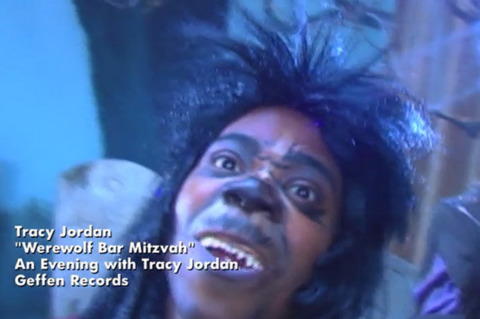
Then you have horror games as we know them today, where they're largely the effort of Indie studios who don't have a whole lot of experience or manpower to create anything approaching a gameplay system more complex than "pick up a thing and use it on another thing" and rely instead on basic mechanics and pure atmosphere. The minimalistic Five Nights at Freddy's series, for example, or a linear first-person game like Layers of Fear or Amnesia: A Machine for Pigs. There's certainly a place for what are either called narratively-focused games or walking simulators, depending on how diplomatic that person feels like being, but without that mechanical depth they usually come off as little better than interactive ghost house rides. Fun enough for a few spooks on a dark night, but shallow compared to almost anything else out there.
My favorite horror game series are those that manage to find a balance between compelling and layered gameplay and a spooky storytelling atmosphere that doesn't preclude jumpscares but also doesn't lean too heavily on them. They include series like: Forbidden Siren, which had you relying on a "sight-jacking" which let you see the world through the enemies' eyes, allowing you to anticipate their movements and sneak past them; Silent Hill, which gave you a means of detecting enemies but very little in the way of effectively defending yourself from them, striking a balance between helpless and a monster-killing badass; and the Project Zero/Fatal Frame games, which expertly created a combat system designed to scare the hell out of you, as you focused on spectral enemies in first-person with a camera and snapped them mid-pounce as close as possible. It'd be tough to create anything like those in the Indie space, given that they all had teams of developers and major publishers behind them, and is a large part of the reason why it's kind of a bummer that the big studios have all but left horror games behind or, in the case of Sony and Until Dawn, disregard them to the extent that they help very little when it comes time to promote them. Realistically, for the time being, we're only going to have the occasional aberration like Amnesia: The Dark Descent as a quality Indie horror game with enough going on mechanically to keep one's interest. Or maybe VR will turn out to be the catalyst to galvanize the major studios into investing in survival horror games again? I guess time will tell.
New Games!
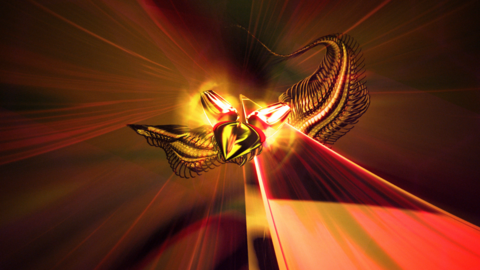
Holy crap are there a whole lot of new games this week, and that's before you consider the launch line-up of the official PSVR debut this Thursday. I don't envy the Giant Bomb crew, or any other early reviewers; while there's no getting around the fact that playing games early and discussing them is a sweet gig, it's not quite so conducive to enjoying them when you need to hurry up because there's three or four more games you gotta play immediately after it. Like having a banquet meal and only five minutes to eat as many of its courses as possible. I suppose GB has less of an impetus to play absolutely everything, but it's still going to be a heck of a busy time.
Anyway, the highlight release for me this week is Dragon Quest Builders, if only because I've spent a sufficient enough time with its demo to be fully on board with more DQ even after last month's Dragon Quest Heroes. I think I mentioned back when I wrote about the latter that I perhaps enjoy the universe, the sense of humor and the overall presentation of Dragon Quest more than I do its slow-paced turn-based gameplay (and from a JRPG fanatic, that's saying something about how ponderous those games can be), which is why I tend to get more attached to the speedier spin-offs like Rocket Slime, Swords and Heroes over the core games. Builders is, of course, the Minecraft-inspired building game that still sticks to cubes and the like, but held together by DQ's charismatic aesthetic and various short- and long-term goals to pursue. If only in terms of having some concrete direction, it's probably closer to Terraria than Minecraft. I'm stoked to play the full thing some day soon.
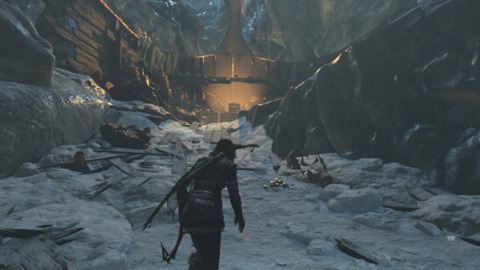
Closely following that is Rise of the Tomb Raider: 20 Year Celebration, a special edition version of the Xbox One Tomb Raider reboot sequel coming to PS4. This'll be the first opportunity I have to play the newest Tomb Raider, and I definitely liked the previous one enough to stick with the direction these new ones are moving towards. It'll mean another open-world game filled with collectibles too, though, which I'm starting to think I might have to cut back on after this year's many offerings. You know what they say about moderation - I already practice one kind on here, so I should consider trying the other.
Games I'm less inclined to buy immediately but are still very interested in include 100ft Robot Golf from the No Goblin crew. I enjoyed what little I could play of Roundabout, though it sure got tricky enough that the slow-down I was getting on PC meant I couldn't hope to progress further, but I liked the moxie behind its FMV presentation. Knowing that the McElroy boys are behind the calm but thoroughly ridiculous golf commentary for this new game is definitely a strong plus in its favor, though I'm sure all the mecha anime goofs will fly right over my head like Amuro Ray in his RX-78-2 Gundam (I... may have picked up a little from osmosis after working on so many Gundam Super Famicom pages).
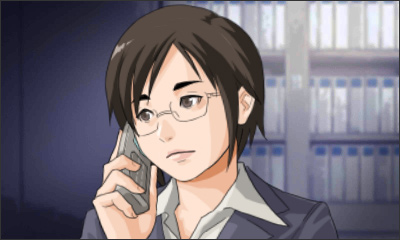
Chase: Cold Case Investigations: Distant Memories is a game I've been keeping an eye on, which is to say I heard about it once and forgot all about until I saw it on the release schedule this week (I get distracted a lot). It's a 3DS adventure game helmed by many of the same folk - including Taisuke Kanasaki, the lead designer - who worked with CING to create a string of games I hold in very high esteem, in particular the Kyle Hyde duology for DS: Hotel Dusk: Room 215 and Last Window: The Secret of Cape West. Chase: Cold Case Investigations seems to crib more from those two games in particular, once again focusing on hard-boiled detectives getting to the bottom of things. It's a game I'm not sure GB will cover with all the PSVR business this week (hopefully @Vinny "AdVinture Game" Caravella has my back), so I'm anxious to see what it's like.
There's way more new releases this week, so here's a quick round-up of the best of the rest:
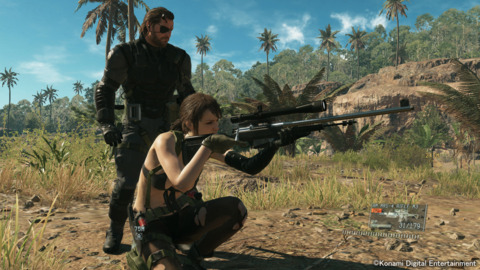
- Metal Gear Solid V: The Definitive Experience is something I'd be interested in if I hadn't just spent a hundred plus hours in the basic model. I also sorta don't trust Konami to treat that game with any respect, if Metal Gear Survive tells us anything, so I'm apprehensive about what they may have added to this version besides the Metal Gear Solid Ground Zeroes prologue game.
- WWE 2K17 sees Yuke's and 2K's wrestling series continue to DDT its own credibility, once again refusing to add important features like the story creation mode back into the series after it was stripped down to just its lycra wrestler pants for the new generation of consoles back with 2K15. I've long grown weary of VGCW and its off-shoots, but I've kept a flame burning for the possibility of Ghost Problems HD.
- Duke Nukem 3D: 20th Anniversary World Tour sees the once mighty ass-kicker and one-liner delivery man return to his roots - except, well, his roots would be the 2D games, so maybe this is the lower part of the stem? I suck at plant analogies, turns out - hoping the world forgets about Duke Nukem Forever. Remember when the original Shadow Warrior was rereleased and was then soon followed by a modern reboot? And then it happened again with Rise of the Triad? I don't think that's going to occur here.
- Gurumin 3D: A Monstrous Adventure is one of the least expected 3DS remakes to appear in a while, a cutesy action RPG that has been bouncing from PC to console and back again, most recently showing up on Steam. This is fairly standard practice for its developer Falcom, which is one of the few Japanese developers that is more comfortable on PC than on console. As a Falcom fan, I'll probably need to check this out eventually.
- Thumper is the one new VR game that seems to be turning heads and blowing out eardrums, and we're fortunate enough to see a non-VR version released the same day. I'm not sure I have the reflexes to get too far into it (maybe no-one does), but it sure seems like a blast.
And, finally, I should acknowledge the huge number of VR games out this week for the PlayStation 4. I sincerely doubt that any of them will convince me to invest in a headset, but I appreciate that they give us a whole lot of great Giant Bomb streaming material for the duders to work with. So thanks for that.
Wiki!
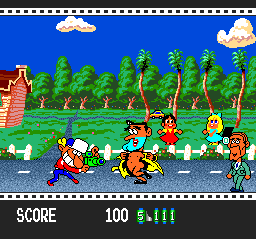
Happy to announce that the Giant Bomb Wiki now has a (mostly) complete page for every single PC Engine HuCard release. I completed the last eleven pages for 1992 this week, and the huge number of releases for 1993 and 1994 as well - six games all told! I tell ya, developers abandoned that little limited rectangle pretty quickly once the SNES and CD-based gaming took off. While I'm not quite finished with the PC Engine - there's still all those CD releases, after all - I am done with it for the time being, and can concentrate on a few miscellaneous clean-up and release work (like SNES/SFC/PCE games that were rereleased on the Wii's Virtual Console or PSN) tasks before moving onto the next big project.
That means we're on cooldown for right now, and I don't imagine I'll have any more big milestones to hit for the rest of the year, but the wiki train don't stop and so I'll almost certainly have something to report in this space every week. Just... not a particularly big something most weeks. Perhaps that's for the best, if we're getting "New Games" sections as large as the above for the rest of 2016.
Let's just have a brief summary of the final seventeen HuCard games so I can save some material for the final "Legend of the PC Engine" round-up blog coming later this week:
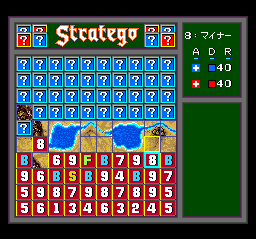
- Nekketsu Koukou Dodgeball-Bu PC: Soccer-hen is Technos' attempt to transplant onto a new sport their wild and violent take on dodgeball in the Kunio-kun universe of ruffians, in this case switching to soccer. As with the dodgeball games and the many brawlers that came before it, there's a stronger emphasis on clobbering your opponents for the upper hand than in most soccer sims. Hey, if the ref didn't see it...
- The Tower of Druaga is the special PC Engine reimagining of Namco's classic Arcade action RPG, figured by many to be the great-grandfather of the JRPG genre, and with it includes a few more overt RPG mechanics like progressing in stats and switching weapons and equipment while climbing the eponymous structure.
- Stratego is a Japan-only console version of the 1990 Atari ST/Amiga adaptation of the basic strategy board game kids learn to master before they're ready for Risk or, the God-Emperor forfend, Warhammer 40k. If you're not interested in the basic Napoleonic characters that Stratego is best known for, the game offers RPG monsters and sci-fi spaceships as alternate tile designs. No two-player mode though, so it's not something that'll last.
- Tatsujin is better known in North America as Truxton, an Arcade vertical shoot 'em up that was one of the earliest games for the Sega Genesis. It looks approximately the same on the PC Engine, though considering it was originally released in 1988 it's kinda hopelessly outdated by 1992. That's a genre that evolved very quickly.
- Power League 5 is yet another Power League baseball game from Hudson. Hudson was one of the original founders of the PC Engine and its most stalwart supporter in the game industry, and this annual baseball series was therefore one of the few mainstays for the console until its eventual end.
- Honoo no Doukyuuji: Dodge Danpei is actually a game I've covered before, back while I was working on SNES pages. It's one of a surprisingly few SNES/PCE overlaps, though when you compare the graphical capability for the two systems you can understand why the PC Engine generally avoided trying to match Nintendo's juggernaut.
- Gekisha Boy is the last of the Japanese HuCard games that I covered on TurboMento-12/Octurbo. It's that super bizarre side-scrolling photography game where you're angling for all the best blink-and-you'll-miss-it photo opportunities while avoiding various perils on the road. It's one of the more entertaining and novel games for the system, but probably kept out of North America for a whole bunch of licensing and nudity reasons.
- Fire Pro Wrestling 3 Legend Bout is the last HuCard Fire Pro game. The series would abandon its original platform and stick to the SFC for a while after this, which is perhaps the console it's best known for.
- Terra Cresta II is, like Tatsujin, a shoot 'em up that is perhaps a little too dated. Oddly, the game was created brand new for the PC Engine specifically, rather than being a years-old Arcade game. You'd think Nihon Bussan would've bothered to evolve the formula at all.
- Momotarou Densetsu Gaiden Dai 1-Shu has Hudson once again dropping in on their old pal Momotarou for another turn-based RPG, but this game instead takes a break from the eponymous Peach Boy to focus on three new characters, each with their own campaign. It's one of those scenario-based RPGs that briefly gained popularity in the 90s.
- F1 Circus '92 is, like Fire Pro, a long-running series that would have a much greater presence on the Super Famicom, but began on the humble PC Engine. While the rest of the world didn't see a single F1 Circus game, this was the video game series for Formula One enthusiasts in Japan, due to the publishers Nichibutsu owning the various licenses to use real driver and team names.
- Tsuppari Oozumou Heisei-han is a graphically-improved remake of an NES sumo game that was built to be on the Arcade-y side, with a lot of timing-based feats of strength.
- J-League Greatest Eleven is based on the Japanese professional soccer league of the same name. The J-League had just been formed in 1993, the first ever professional league for the sport, so there were a number of games that jumped on the fledgling competition to help establish it.
- Power Tennis sees Hudson take on tennis instead of baseball, creating a moderately fun approximation that allowed for up to four human players in doubles matches. It's solid enough, but perhaps Final Match Tennis would've served you better.
- Power League '93 is, despite having "league" in the title and being sandwiched between two J-League games, the sixth game in Hudson's baseball series. I think they were running out of ideas by this point, and replacing the numeral with the present year in the title as if it would see many other annual successors might have been a little on the optimistic side.
- Formation Soccer on J-League is another J-League game unrelated to the previous, though still covering the same first year of the competition. At this point there were only ten teams, so both it and Greatest Eleven were fairly limited.
- 21 Emon: Mezase! Hotel Ou, ak.a. the last official HuCard game ever produced, is fortunately not a sports game. What it is is (that's some good wordage), is a Monopoly-style board game based on a family sci-fi anime about some hotelier kid. From what little I played, it strikes me as a balance between standard Monopoly and the random good or bad events of the various Game of Life adaptations for Japanese systems. It even has Mario Party style mini-games at the end of every turn. I'm glad the HuCard legacy ended on something suitably strange.
Batman: Arkham Knight!
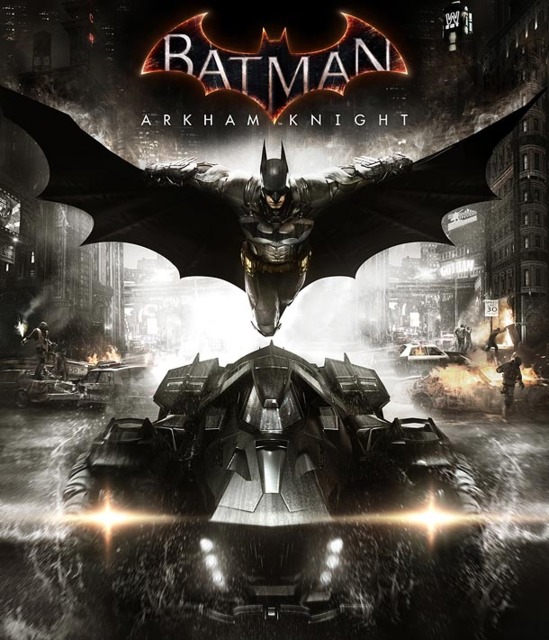
At this point I'm winding down with Batman: Arkham Knight, having completed the game's story and now sweeping up the remaining "Gotham's Most Wanted" side-missions and Riddler trophies (so many Riddler trophies...) before I move onto whatever huge new open-world game is next. My early impressions last week are still as pertinent now as they were then, though I will say that with enough time you eventually get used to the game's dizzying number of gadgets and features.
I'm in two minds about the general complaint of having more options than you know what to do with; you can argue that the breadth of versatility is a huge boon for the strategically-minded, and that in turn helps to emphasize what is perhaps one of the most important advantages of the Batman character. That is, that the guy is a genius - a deductive, technological and tactical mastermind - and any Batman game worth their salt has to allow for the player to be as cunning as Bruce Wayne himself. Watching a group of armed thugs in the game's stealth-based "predator" mode, for example, the player is given a wide range of alternatives in how they choose to approach them. They can single out guards who patrol away from the group, sweeping down for a quick silent takedown before hooking back up to a safer vantage point. Batman can use his gadgets to "set up the board", as it were, placing explosive gel and freezing proximity mines to set ambushes, or using a cool "Disruptor" weapon to disable guns, rig drones to explode and cause medics to be shocked into unconsciousness if they choose to help a fallen ally before announcing himself. Often though, these gadgets tend to overlap to a confusing degree: Batman picks up a Remote Hacking Device, a taser-like firearm that sends out an electric bolt designed to incapacitate, and the aforementioned Disruptor, and each provides a similar effect but is still highly conditional - a gun turret will be blinded once hacked, will start firing wildly to cause a distraction when shocked and have no effect when a disruptor is fired at it, but a drone turret - of which the only real difference between it and the gun turret is that it's slightly larger and kills you quicker - will be blinded once hacked, won't be effected at all by the shock and will explode when disrupted (provided the player has the right upgrades). Other mechanical/computer devices like door switches and remote controls seem to be affected in odd, occasionally unintuitive ways by the three devices too.
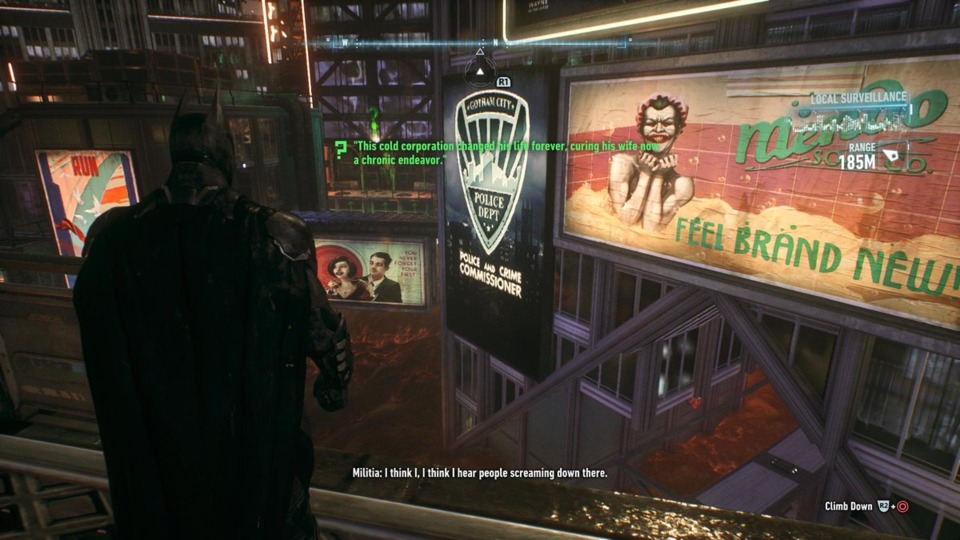
Which is where the other side of the scratched up coin comes in. I couldn't say with any authority what necessarily constitutes good or bad design besides pointing at what works and what doesn't - that's true of all game designers, in reality, who generally need to implement an idea and then test it thoroughly before they can be assured that their addition was a wise one. However, I tend to think that some genres lend themselves better to giving the player a wider array of options than others. In particular, the slower-paced games that allow for some ratiocination - anything turn-based, particularly, though there are plenty of games that move slowly enough to give players time to think - are better suited for a heightened degree of strategy than those where the action moves too quickly to concentrate on too many factors at once. When you're in the middle of a pitch brawl with multiple opponents flinging punches, there's far less time to consider the twenty different button combinations that lead to your various gadget-assisted takedowns and moves, each of which has a conditional role in a fight. Shocking an opponent with an electrified stun baton, for instance, knocks it out of their hand and makes them less of a threat, and using specific combinations is the only reliable way of taking down the larger brute enemies or the opponents with shields. When you have all that to consider on top of the situational awareness to prioritize targets like those with guns, or medics that will heal fallen foes when your back is turned, it can be a heck of a lot of feedback to deal with in between hitting counters at the right time and smartly maneuvering around the crowd via flips and rolls. The Batman Arkham series's utility belt of weaponry and gadgetry expands with every new game, and so to does the intelligence of your enemies as they adjust to what you're doing and have already come up with many ways to block your old tricks (the game's secondary antagonist, the titular Arkham Knight, is established to be a foe well-versed in Batman's tactics), that the game becomes needlessly frustrating in forcing errors. You could also point to this as the game shaping up and creating a level of challenge suitable for a player already familiar with the previous games in the series, and I think there's merit in either side of that argument.
The game also takes various measures to ensure that Batman never kills anyone, to occasionally absurd degrees. Every single one of Batman's combos and finishers are designed to quickly take his opponent out of the fight but not seriously injure them beyond the occasional broken bone or spine trauma. This is one of those situations where the game designers must've been very careful to consider every possibility, making sure to mitigate the severity of inadvertent explosions or removing the possibility of knocking a guy off a roof to his death, though it's less impressive here after three whole games of similar considerations. The game does cheat a little by having almost all the enemy vehicles be remote-controlled drones, allowing you to explode them with impunity, but I imagine it would've been easy to neglect what is another important aspect of Batman's character for the sake of making the game easier to code and design. One that the recent movie certainly didn't seem quite so eager to preserve.
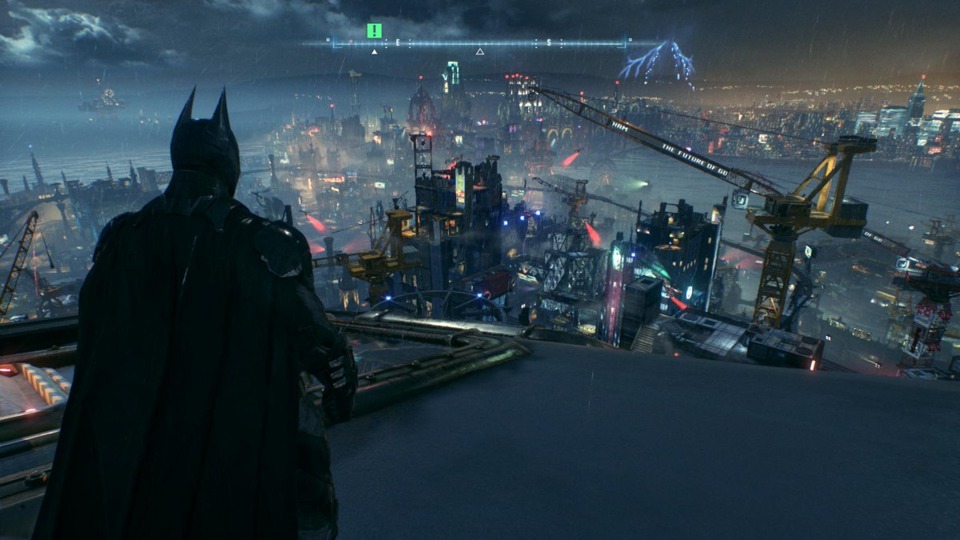
There's also the Batmobile. While I initially didn't feel comfortable with the amount of attention the tank-car was receiving in lieu of more traditional Batman Arkham action, it won me over with some useful upgrades that helped alleviate the punishing tank battles in some of the later story scenarios. For instance, I relied far too much on the tank-like 60mm gun early on, and when I picked up the accuracy boost for the more rapid-fire Vulcan Cannon I began to appreciate how carefully lining one's shots while avoiding incoming shells made those sequences more survivable and more fun. You see, many of the larger drones require multiple 60mm shots to destroy, and the 60mm gun needs some time to reload between each shot, so I'd end up getting blasted to heck by a huge number of opponents who were appearing faster than I could blow them up. However, the game eventually teaches you that each drone has a very obvious blue or orange light sensor that it uses to target you, and a single shot with the Vulcan Cannon to those sensors will cause the drone to explode immediately regardless of its size. The difficulty is in lining these shots up, as it's literally a very small window. So instead of being a rough-and-tumble battle of attrition between your tank cannon and theirs, it becomes something more akin to Dan's beloved John Wick where you're instinctively moving into vantage points where you can simultaneously evade their attack and end them with a single decisive bullet in return. I still didn't care for Riddler's race courses, but the dual battle-mode does at least make it easier to fix screw-ups as the hovering quickly allows you to course-correct for the more car-like "pursuit" mode to continue racing.
Ultimately, though, while I'm sometimes frustrated at the level of challenge the game can present, it's also keeping in line with Batman's ability to out-think, not necessarily out-muscle, his foes. Couple that with the game's sterling presentation - Gotham looks absolutely incredible in this game - and the amount of content it manages to pack into its three islands, and I'd probably admit to it being one of the better games from last year. Albeit begrudgingly, after yet another predator mission goes belly up because of a stupid error I didn't anticipate or after I stared dumbly at a Riddler puzzle for too long which turns out to require one of the game's dozen mechanics you rarely use or would ever consider, like the finnicky slide or using the explosive gel to activate switches (why would that even work? Agh!). For as much as I can remark on its quality, I think it's probably for the best that Rocksteady made this the final Arkham game, because it they're getting dangerously close to being overbloated. If I wanted bloated Batman, I'd go watch the 1966 movie again.
Dragon Quest Builders Demo!
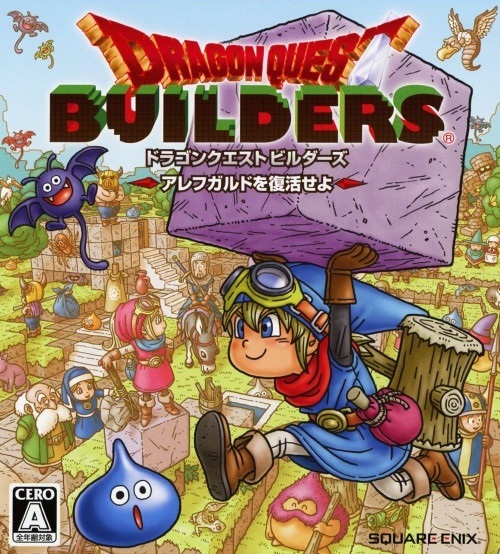
I figured if the game was coming out this week and I'd already heard positive things from a number of sources including Jeremy Parish over on USGamer.net, that I might as well try the free demo of Dragon Quest Builders that had been put on PSN. Crafting/survival games can often go one of several directions, and most of those directions don't appeal to me in the slightest. While DQ Builders does bring a lot of that genre baggage along with it - there's an incessant hunger gauge, there's a lot of aimlessly wandering around scavenging materials, there's some compulsory combat - I'm already attached to the game's idea of progression.
Dragon Quest Builders posits an alternate universe in which the hero Erdrick joined the villain Dragonlord at the end of the very first Dragon Quest instead of refusing his offer like a good little hero should, causing the world to fall into darkness. This age of darkness is cleverly reflected as a Dark Ages as well: a period of anti-intellectualism where the vast majority of humans have lost the ability to read and write and create and instead selfishly scrabble out solitary existences by running around in rags hitting things with rocks (essentially, the same way every open-world survival game on Steam begins). The player is "Bildrick", a fellow who wakes up in a cave with a divine voice calling to them to get out and explore and do the hero thing - the game manages to pip The Legend of Zelda: Breath of the Wild to an almost identical opening - and is someone with the unique talent of figuring out how to build things. This gift comes in two parts: taking materials in the environment, including blocks of dirt, and using them to craft new items and structures; and figuring out blueprints to new objects and buildings by thinking about them a little.
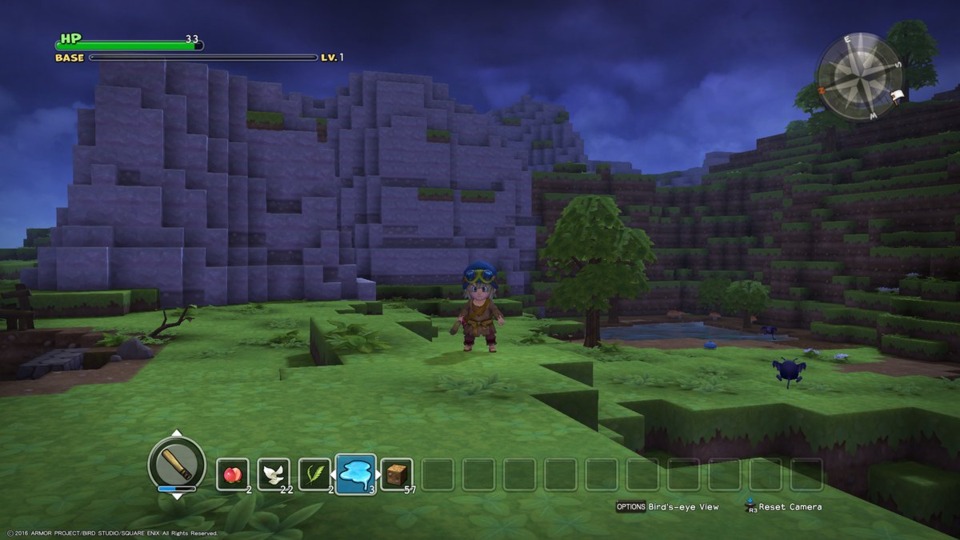
The game's tutorial comprises roughly 70% of the demo, but it's a fairly long tutorial: you learn how to build houses, which have Terraria-style requisites before they "click" as rooms (most just need walls two blocks high and a light source); you learn the game's basic combat, which is about as sophisticated and non-essential as its Minecraft inspiration; and you learn how to take requests from townspeople and the importance of developing towns. The latter is the game's major centerpiece, where you're frequently returning to a settlement to expand it, either by developing new buildings or repurposing the buildings you already have to fit roles the community needs. The game seems a little limited in terms of verticality - the rules seem to suggest that most fixtures need to be at ground level for their effects to count - but that's largely tied into how towns expand in width and length after particular milestones are met. If you develop a town enough to reach the next level, the area you can build on grows to provide the next level's development requirements. All the while you're building rooms for new NPCs to live in while taking on their various side-quests for resources and utilities like a communal kitchen or a craftsman's hut. The game then anchors you to this location, allowing you to roam around the countryside for resources and come back for a place to store your finds (items stored can be accessed through the crafting menu, which is always welcome) and to sleep through the night, when tougher creatures are lurking around.
The presentation has been very Dragon Quest: I've met drackies, slimes, chimaeras, skeletons and nasty looking treants so far, each of which looks almost identical to how they did in Dragon Quest Heroes and other 3D Dragon Quest games. It's a bit of a shift to have some trouble against minor enemies like these, whereas in DQH I'd be killing them by the dozens from the get-go, but Dragon Quest Builders makes it clear that Bildrick is no hero: he doesn't even level up, but rather he levels up the towns he builds and in doing so unlocks new equipment recipes to make himself more durable. The demo cuts off just as it threatens to expand to a new area with the introduction of teleportals, leaving us cheapskates to continue exploring the still substantial immediate vicinity and building their stunted village in however way they want. I'd hope the demo save file will still be accessible in the main game so I won't have to go through all those tutorials again, but it definitely left me with my interest piqued. When it comes out this Tuesday, I'll be keeping a close eye on everyone's thoughts.
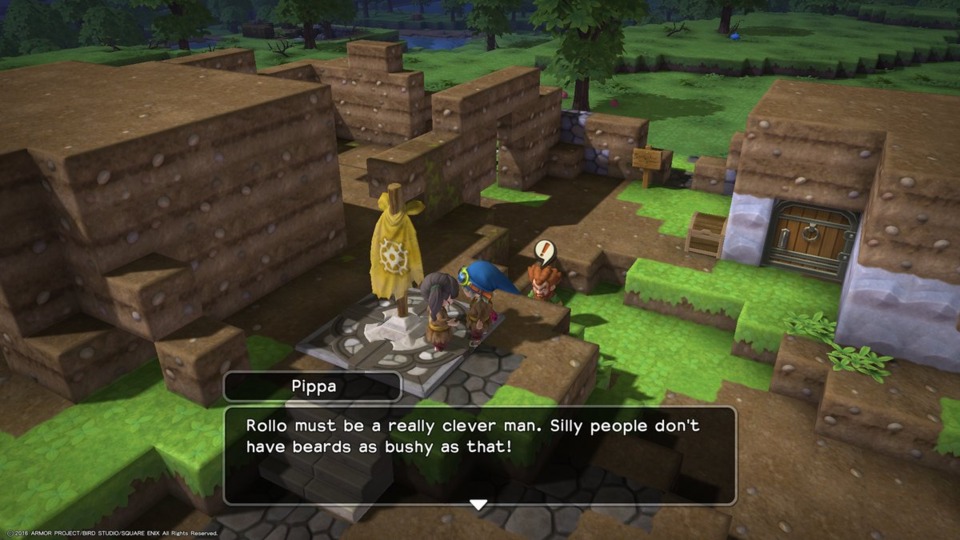

2 Comments